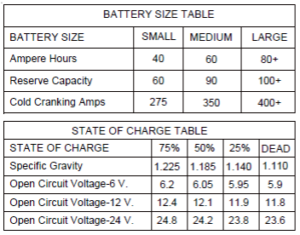Standard 12V AGM Setting Operation and Cycling (6006AGM/6009AGM/6012AGM):
1. The battery charger, under normal operation using the “12V AGM” setting, charges the battery until the cutoff voltage is reached (14.6 to 15.0V) and the charger turns off.
2. After the charger turns “OFF” the battery voltage declines, when the battery voltage falls below the “TURN ON” voltage (12.7 to 13.0V); the charger will “TURN ON”. The cycling frequency (ON/OFF) depends on several factors:
- BATTERY SIZE (smaller battery = faster cycling)
- BATTERY STATE OF HEALTH (weaker battery = faster cycling)
Chargers experiencing a higher frequency of “ON/OFF” cycling are typically being used on smaller or weaker batteries. If this happens, it would be a good idea to test the battery with a load tester to make sure it has capacity
A battery in good working order will slowly ramp up to the finish voltage while charging and
when the charger turns off, will hold its voltage
NOTE: The fan is not normally ON when using the AGM setting, unless the battery is very discharged and the output current is high.
3. If it is a “GOOD” battery, when the voltage levels are met, the charger typically turns off and the battery
is READY for use.
HOW LONG DO I NEED TO CHARGE MY BATTERY?
When trying to determine how long to charge a battery, we must have a few pieces of information first to calculate with.
- What size is the battery?
- How discharged is the battery?
- What rate will we be charging the battery?
In determining the size of the battery, sometime the batteries are rated in amp hours (AH), and sometimes they are rated in cold cranking assist (CCA). In order to know how many amp hours we need to return to the battery, we need to know its amp hour capacity.
A crude formula for this calculation would be CCA ÷ 8.3 (i.e. 600CCA ÷ 8.3 = 72 AH’s approximately)
Next is to determine the state of discharge of the battery. The STATE OF CHARGE table below will give you a good idea of the discharge state of the battery. A battery is considered mostly charged if the open circuit voltage reads 12.6 or higher when measured with a multi-meter, whereas at 11.8 volts it is considered 100% discharged.

The last piece of information is the easiest. What rate are you going to set the charger at?
Let’s assume we have a 600CCA battery that is discharged to 11.9 volts and we want to charge it back on a 40amp setting. It would look like this 600CCA ÷ 8.3 = 72AH x 85% discharged ÷ 40 amp setting on charger x 1.25
Or 600 ÷ 8.3 x .85 ÷ 40 x 1.25 = 1.9 (approximate hours to charge)
CHARGER MAINTENANCE & CLEANING INSTRUCTIONS
1. Worn clamps and jaws should be replaced. Worn parts can lead to poor connections and present a safety hazard. See parts list for part number of jaw and clamp kits. Any Maintenance or repair of this unit that involves disassembly of the cabinet should be done only by a qualified service person.
2. Incorrect reassembly may result in a risk of electric shock when the unit is subsequently used. To clean, wipe with a soft damp cloth. Avoid the use of chemical and abrasive cleaners. Wipe up spills immediately.
3. Furniture polish may be used to maintain a bright sheen on the cabinet and cables, but avoid spraying directly onto the metal and apply to a cloth and rub it in.
4. When not in use, the unit should be stored upright, in a dry location.
5. If there are signs of cabinet damage, have the unit checked by a qualified service person before using.
DOES MY CHARGER NEED REPAIR?
There are some very basic tests to initially perform to determine if service is required on the charger before having to remove any panels. These tests can be performed without exposing the operator to any potentially lethal voltages. Visual and audible clues during this process will also help identify any problems you may be having. Although not always possible, first hand information from the operator will many times give a good indication as to the failure of the charger. Ask lots of questions, such as:
• By what means have you determined the charger to be defective?
• How long has the charger been in service?
• Has the charger ever worked or is this an out of box failure?
• How was the charger being used? (charging, jump starting, etc.)
• What is the application of the charger? (automotive garage, junk yard, truck shop, etc.)
• Did you hear, see or smell anything prior to the charger failing?
• Was the charger working and just quit, or was it not working from the time you plugged it in?
